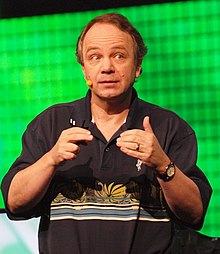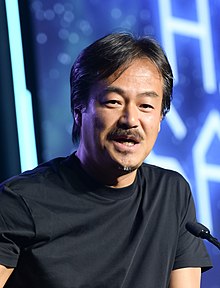The Video Games Portal

A video game or computer game is an electronic game that involves interaction with a user interface or input device (such as a joystick, controller, keyboard, or motion sensing device) to generate visual feedback from a display device, most commonly shown in a video format on a television set, computer monitor, flat-panel display or touchscreen on handheld devices, or a virtual reality headset. Most modern video games are audiovisual, with audio complement delivered through speakers or headphones, and sometimes also with other types of sensory feedback (e.g., haptic technology that provides tactile sensations). Some video games also allow microphone and webcam inputs for in-game chatting and livestreaming.
Video games are typically categorized according to their hardware platform, which traditionally includes arcade video games, console games, and computer (PC) games; the latter also encompasses LAN games, online games, and browser games. More recently, the video game industry has expanded onto mobile gaming through mobile devices (such as smartphones and tablet computers), virtual and augmented reality systems, and remote cloud gaming. Video games are also classified into a wide range of genres based on their style of gameplay and target audience. ( Full article...)
Featured articles –
X-treme was conceived as a side-scrolling platform game for the Sega Genesis to succeed Sonic & Knuckles (1994). Development shifted to the 32X and then the Saturn and Windows, and the game was redesigned as a 3D platform game for the 1996 holiday season. The plan was disrupted by company politics, an unfavorable visit by Japanese Sega executives, and obstacles with the game engines planned for use, including one from Sonic Team for Nights into Dreams (1996). Amid increasing pressure and declining morale, designer Chris Senn and programmer Chris Coffin became ill, prompting producer Mike Wallis to cancel the game. A film tie-in with Metro-Goldwyn-Mayer was also canceled.
In place of X-treme, Sega released a port of the Genesis game Sonic 3D Blast, but did not release an original 3D Sonic platform game until Sonic Adventure for the Dreamcast in 1998. The cancellation is considered an important factor in the Saturn's commercial failure, as it left the system with no original Sonic platform game. Elements similar to those in X-treme appeared in later games, such as Sonic Lost World (2013). ( Full article...)
The game began development in 2008. Key first conceived Proteus as an open-ended role-playing game akin to The Elder Scrolls IV: Oblivion but, because of the work required for such a project, later redesigned it to be "nontraditional and nonviolent". Audio designer and composer David Kanaga joined the project in 2010. Versions for the PlayStation 3 video game console and Vita handheld console were developed by Curve Studios, whose team added new gameplay features to the Vita edition at Sony's request.
Proteus won the prize for Best Audio at the 2011 IndieCade awards, and was a finalist for the 2012 Independent Games Festival's Nuovo Award. Following its release, critics praised the game, especially for its audio features, although some criticised the game's brevity and limited replayability. The game was frequently mentioned in discussions of video games as art, with some debating whether it could be considered a video game at all. ( Full article...)
Rare began working on Donkey Kong 64 in 1997, following the completion of Donkey Kong Country 3 (1996). It was conceived as a 2.5D platformer similar to Country before becoming a more open-ended game using the engine from Rare's Banjo-Kazooie (1998). A 16-person team with many recruits from the Banjo group finished it in 1999. It was published by Nintendo in North America in November and worldwide in December. Donkey Kong 64 was the first game to require the Nintendo 64 Expansion Pak, an accessory that added memory resources. The US$22 million marketing campaign included advertisements, sweepstakes, and a national tour.
Donkey Kong 64 received acclaim and was Nintendo's top seller during the 1999 holiday season; it ultimately sold 5.27 million copies worldwide. It won the 1999 E3 Game Critics award for Best Platform Game and multiple awards and nominations from magazines. Reviewers praised the exceptional size and length, but criticized its camera controls and emphasis on item collection and backtracking. Some cited its gameplay and visual similarities to Banjo-Kazooie as a detriment. Critics said Donkey Kong 64 did not match the revolutionary impact of Donkey Kong Country but was still among the Nintendo 64's best 3D platform games. ( Full article...)
Taking place 1500 years after the events of Blood Omen, Soul Reaver chronicles the journey of the vampire-turned- wraith Raziel, lieutenant to the vampire lord Kain. Raziel is killed by Kain, but is revived by The Elder God to become his "soul reaver" and to exact revenge. Raziel shares this title with Kain's sword, the Soul Reaver, which he acquires during the game.
Crystal Dynamics began development of the game in 1997, but a deteriorating relationship with Silicon Knights, who had developed Blood Omen, created legal problems. This and other delays forced material originally planned for Soul Reaver to be instead released with later games of the series. Soul Reaver was generally well received by critics and praised for its intriguing gothic story and high-quality graphics. However, the game was criticized for simple and repetitive gameplay and an unsatisfying climax. By 2001, the game sold 1.5 million copies worldwide. ( Full article...)

Gravity Bone is a 2008 freeware adventure game developed and published by Blendo Games. The game employs a modified version of id Software's id Tech 2 engine—originally used for Quake 2—and incorporates music from films by director Wong Kar-wai, which were originally performed by Xavier Cugat. Four incarnations of the game were produced during its one-year development; the first featured more common first-person shooter elements than the released version. Subsequent versions shifted in a new direction, with the inclusion of more spy-oriented gameplay. The game was released for Microsoft Windows in August 2008.
Gravity Bone received critical acclaim from video game journalists. It was called "a pleasure to experience" by Charles Onyett from IGN, and received comparisons to games such as Team Fortress 2 and Portal. The game was praised for its cohesive story, atmosphere and its ability to catch the player's interest over a very short time span without feeling rushed or incomplete. It received the "Best Arthouse Game" award in Game Tunnel's Special Awards of 2008. A sequel, Thirty Flights of Loving, was released in 2012. ( Full article...)
In Tatsunoko vs. Capcom, players engage in combat with a team of two characters or with a single giant character and attempt to knock out their opponents. It is the seventh Capcom-designed installment in their Vs. fighting game series, which includes the Marvel vs. Capcom and Capcom vs. SNK series, and the first to be fully rendered in 3D graphics. The game is set in a 2.5D environment; characters fight in a two-dimensional arena, but character models and backgrounds are rendered in three-dimensional graphics. The game is designed around a simplified three-button attack system, which was inspired by the simplistic control schemes commonly used by both the Vs. series and the Wii.
The game received generally positive reviews from critics, who praised its approachable gameplay for newcomers and depth for veteran players. However, reviewers had mixed experiences with its online component, and found Arcade mode lacking in replay value. According to the game's producer, Ryota Niitsuma, development difficulties and a lack of Wii fighting games were the reasons for its platform exclusivity; however, multiple critics questioned if that was the best choice. Capcom announced in April 2010 that the game was a commercial success. ( Full article...)
Set in a world with technology resembling the Second Industrial Revolution, the game's story follows an expanding cast that includes fourteen permanent playable characters. The narrative deals with the themes of a rebellion against an immoral military dictatorship, pursuit of a magical arms race, use of chemical weapons in warfare, depictions of violent and apocalyptic confrontations, several personal redemption arcs, teenage pregnancy, and the renewal of hope and life itself.
Final Fantasy VI received widespread critical acclaim, particularly for its graphics, soundtrack, story, characters, setting, and mature themes, and won numerous awards. It is widely considered to be one of the greatest video games of all time, and is often cited as a watershed title for the role-playing genre. The game was a commercial success, with the Super NES and PlayStation versions selling over 3.48 million copies worldwide by 2003, as well as over 750,000 copies as part of the Japanese Final Fantasy Collection and the North American Final Fantasy Anthology. ( Full article...)

Final Fantasy is a fantasy anthology media franchise created by Hironobu Sakaguchi which is owned, developed, and published by Square Enix (formerly Square). The franchise centers on a series of fantasy role-playing video games. The first game in the series was released in 1987, with 16 numbered main entries having been released to date.
The franchise has since branched into other video game genres such as tactical role-playing, action role-playing, massively multiplayer online role-playing, racing, third-person shooter, fighting, and rhythm, as well as branching into other media, including films, anime, manga, and novels.
Final Fantasy is mostly an anthology series with primary installments being stand-alone role-playing games, each with different settings, plots and main characters, but the franchise is linked by several recurring elements, including game mechanics and recurring character names. Each plot centers on a particular group of heroes who are battling a great evil, but also explores the characters' internal struggles and relationships. Character names are frequently derived from the history, languages, pop culture, and mythologies of cultures worldwide. The mechanics of each game involve similar battle systems and maps. ( Full article...)
Did you know... -
- ... that the concept of adding strippers to the extreme sports video game BMX XXX was initially proposed in jest?
- ... that Kamibox's video game A Joke That's Worth $0.99 is permanently on special offer because Itch.io does not allow $0.99 as a regular price?
- ... that Kainé from the video game series Nier was created in response to a female staff member's vague wish for a "male heroine"?
- ... that Through the Darkest of Times was the first video game published in Germany to use swastikas?
- ... that the developer of The Stillness of the Wind was inspired to make the video game after fantasizing with his girlfriend about raising goats instead of living in London?
- ... that LittleBigPlanet, a video game that allows the player to create levels, coincided with the rise of user-generated content?
- ... that Terra Invicta's development company is a group of former volunteer video game modders that decided to release their own game after the success of their mod?
- ... that the video game Serious Sam: Tormental was originally inspired by Geometry Wars?
- ... that the 2005 video game Bokura no Kazoku was inspired in part by the birth of its creator's first child?
- ... that the album series Jingle Cats spawned Jingle Dogs, Jingle Babies, and a Japanese video game in which "the object is to breed and care for cats, which begin to sing when they're done copulating"?
- ... that the leak of the upcoming Grand Theft Auto game was described as one of the biggest leaks in video game history?
- ... that the case Lewis Galoob Toys, Inc. v. Nintendo of America, Inc. was considered essential to the future of video game modding in the United States in 1992?
Selected biography –
Selected image -
- May 24, 2024 – Uvalde school shooting
- Families in Uvalde, Texas, U.S., file a lawsuit against Daniel Defense and Activision Blizzard for creating the DDM4 V7 gun and promoting the weapon through the game Call of Duty, respectively. They also sue Meta Platforms for owning Instagram, which was used by the gunman. (AP)
- April 16, 2024 – 2023–2024 video game industry layoffs
- American video game company Take-Two Interactive lays off 5% of its workforce. (Reuters)
- April 10, 2024 – 2023–2024 video game industry layoffs
- American video game company Epic Games announces that it will lay-off around 870 employees, roughly one-sixth of its workforce, due to slower growth than expected. (CBC via Yahoo! News)
Topics
Categories
Things you can do
In other Wikimedia projects
The following Wikimedia Foundation sister projects provide more on this subject:
-
Commons
Free media repository -
Wikibooks
Free textbooks and manuals -
Wikidata
Free knowledge base -
Wikinews
Free-content news -
Wikiquote
Collection of quotations -
Wikisource
Free-content library -
Wikiversity
Free learning tools -
Wiktionary
Dictionary and thesaurus












































